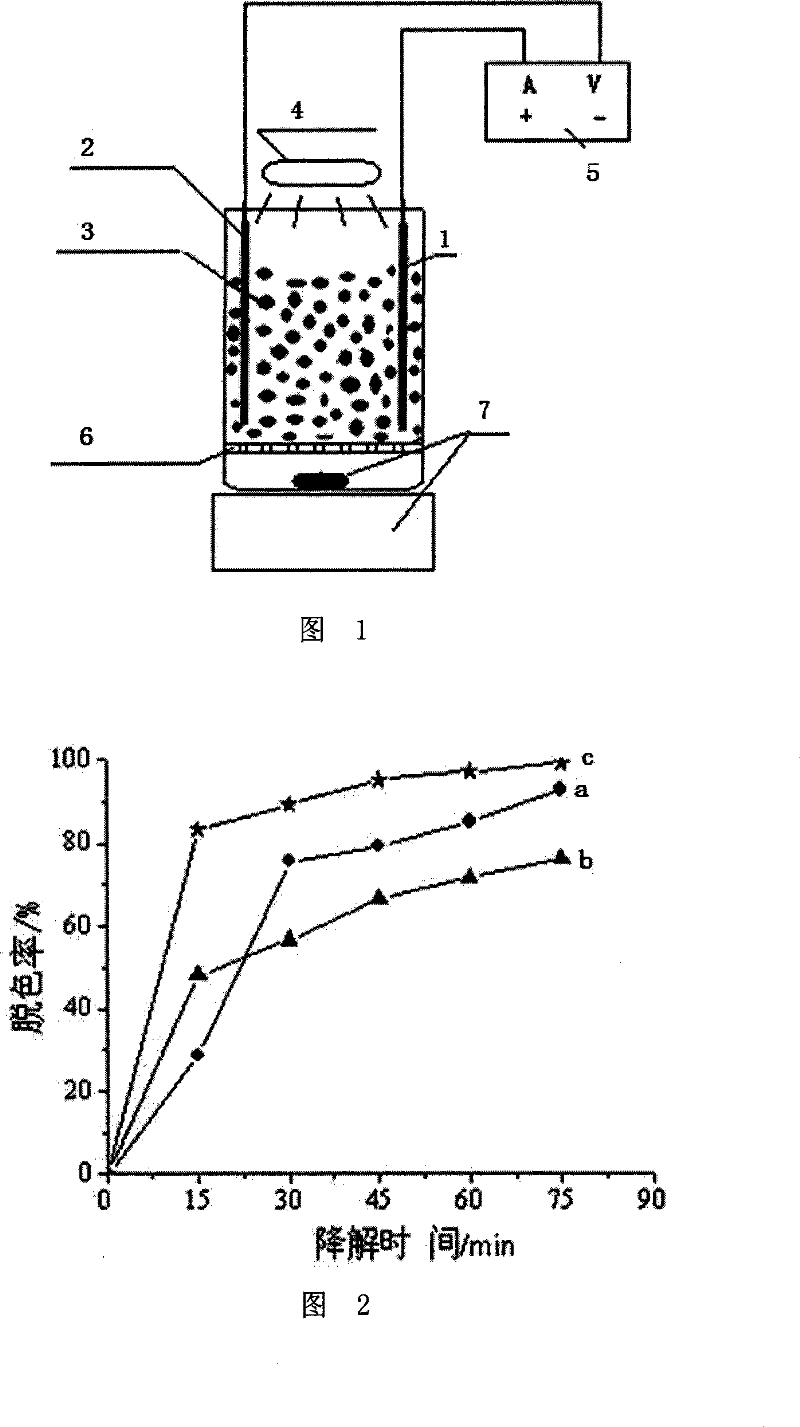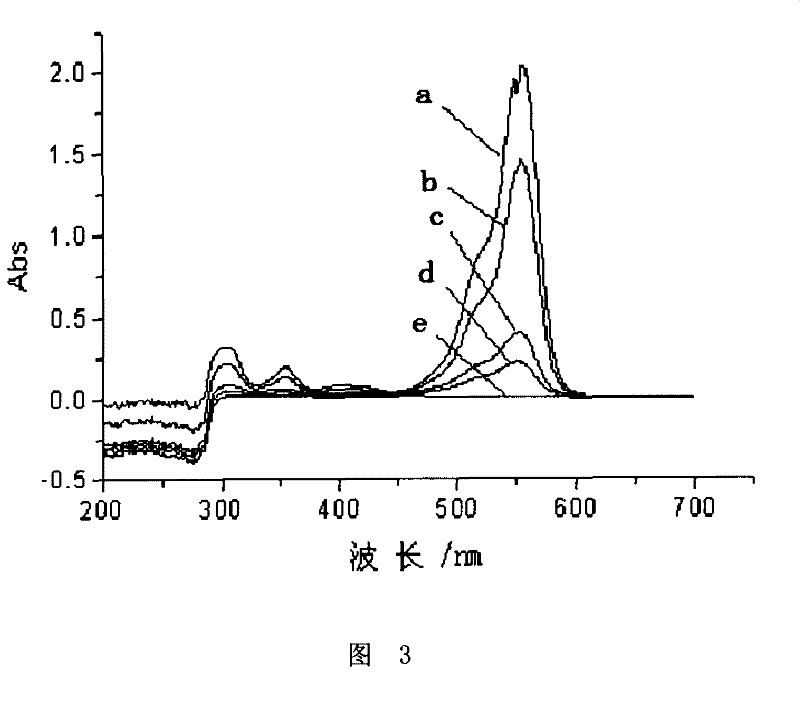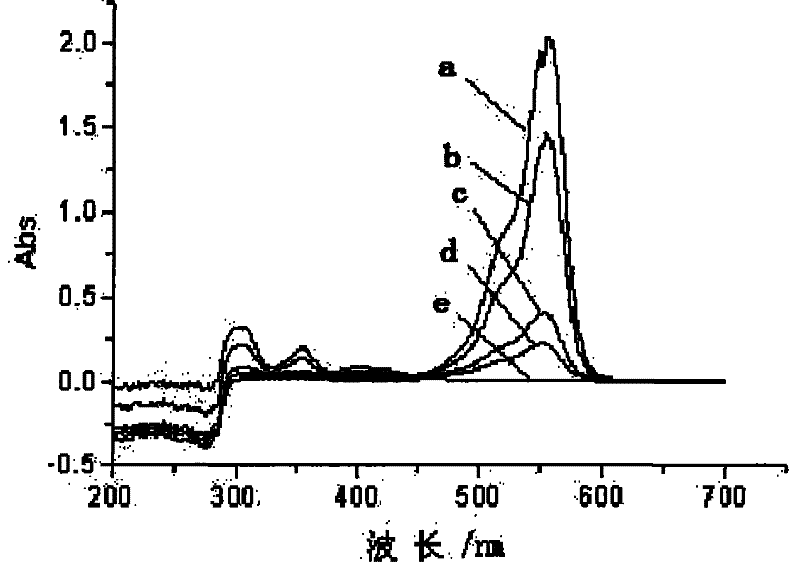A particle electrode with photoelectric catalytic function and its preparation and application
A particle electrode, photoelectric catalysis technology, applied in the field of electrochemical electrodes, can solve the problems of electrodes only having electrocatalytic function but not photocatalytic function, unable to realize photoelectric catalytic synergistic effect, etc., achieving significant social and economic benefits, improving biodegradability, The effect of less investment
- Summary
- Abstract
- Description
- Claims
- Application Information
AI Technical Summary
Problems solved by technology
Method used
Image
Examples
Embodiment 1
[0053] (1) Pretreatment of graphite particles: Soak graphite particles with a diameter of 5 mm and a length of 7.5 mm in distilled water for 24 hours and rinse several times, then boil them in a beaker for 10 minutes to remove air bubbles, leave to cool, filter out water and put them in an oven Bake in medium for 24 hours before use.
[0054] (2) Nano-TiO 2 Preparation of the sol: Take 61 mL of n-butyl titanate and slowly dissolve it in 241 mL of ethanol solution, add dropwise 36 mL of glacial acetic acid, add 36 mL of triton surfactant, add 5 g of polyethylene glycol, and stir at room temperature for 3 After 1 hour, use 1:1 hydrochloric acid to control the pH value to 2 to obtain a stable and uniform solution A; take 18ml of twice-distilled water and dissolve it in 90ml of ethanol to form solution B, slowly add solution B to solution A, and stir for 2.5 hours, a yellowish transparent sol was obtained.
[0055] (3) Immersion aging: immerse the pretreated graphite particles i...
Embodiment 2
[0060] Printing and dyeing wastewater is known as refractory organic wastewater, which has color pollution in addition to COD pollution, and Rhodamine B is one of the refractory organics. The graphite particles with photocatalytic function prepared in Example 1 are filled in figure 1 A third-dimensional electrode is formed between the two flat electrodes in the reactor, and rhodamine B solution with a concentration of 10 mg / L is added, and the particle electrode is discharged after reaching adsorption equilibrium in the form of adsorption, and fresh rhodamine B solution of the same concentration is added again to carry out Light, electricity, and photoelectric catalytic oxidation decolorization degradation, sampling analysis and testing at regular intervals during the treatment process and calculation of decolorization rate calculation ( , where A 0 is the absorbance of wastewater before degradation; A t is the absorbance of wastewater at time t of degradation; both are the...
Embodiment 3
[0064] Measure 61mL of n-butyl titanate and dissolve slowly in 150mL ethanol solution, add dropwise 18mL of glacial acetic acid, add 36mL of triton surfactant, add 5g of polyethylene glycol, add 0.3g of lanthanum nitrate, and stir at room temperature for 3 After 1 hour, use 1:1 hydrochloric acid to control the pH value to 2 to obtain a stable and uniform solution A; take 10ml of double distilled water and dissolve it in 45ml of ethanol to form solution B, then slowly add solution B to solution A, and After stirring for 2.5 hours, TiO doped with elemental lanthanum was obtained 2 Sol; All the other obtained the nano-TiO that loaded element doped lanthanum by the same method in embodiment 1 2 particle electrodes.
PUM
| Property | Measurement | Unit |
|---|---|---|
| diameter | aaaaa | aaaaa |
Abstract
Description
Claims
Application Information
 Login to View More
Login to View More - R&D
- Intellectual Property
- Life Sciences
- Materials
- Tech Scout
- Unparalleled Data Quality
- Higher Quality Content
- 60% Fewer Hallucinations
Browse by: Latest US Patents, China's latest patents, Technical Efficacy Thesaurus, Application Domain, Technology Topic, Popular Technical Reports.
© 2025 PatSnap. All rights reserved.Legal|Privacy policy|Modern Slavery Act Transparency Statement|Sitemap|About US| Contact US: help@patsnap.com



